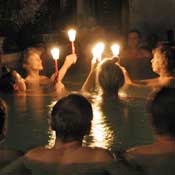
Communal Bathing No Longer A Concept Lost In Translation
Communal bathing is a foreign concept for most Americans. For many Europeans, however, a trip to the local sauna is a time to clean up and relax with friends at the same time.
Joachim Liedtke, a visiting German professor this fall, shared his sauna experience with his German class. Originally from Germany, he has lived in Sweden for several years. In Sweden, Liedtke often visits a sauna situated on the Baltic Sea. The facility features a changing room, showering areas and several different saunas of varying temperatures and humidities.
Historically, Liedtke said, saunas were primarily practical. In cold climates with no showers, the sauna was a place both to clean and warm up. Additionally, more momentous occasions took place in the sauna.
They gave birth to the kids in that room,
Liedtke said. The warmth helped the women relax, easing the pains of childbirth. The heat has several beneficial effects for all practitioners, improving blood circulation, cleansing skin and giving one a chance to unwind.
After the sauna you feel much more relaxed and can deal with problems,
Liedtke said. Unlike the minutes-long shower that most students take, one can spend hours or an entire day at the sauna. Of course, it is unhealthy to spend all this time in the sauna proper. At Liedtke sauna, patrons can relax on an outdoor porch. In colder weather, people nap and read in relaxation rooms. There, people take the opportunity to have a talk or a beer, Liedtke said. In Germany, the sauna experience differs slightly from Sweden. While in both countries all visitors are in the nude, in Sweden people are separated by gender.
Also, German saunas employ so-called sauna masters
who come to the sauna every hour to perform the sauna ritual. They add aromatherapy oil to the water that they throw on the hot rocks, which scents the steam. The sauna master whips a towel around to circulate the heat. Patrons are encouraged to raise their arms above their heads, both to get equal skin exposure and to aid their breathing.
While Americans predominantly shower in the morning, the sauna schedule can be such a lengthy commitment that different groups go at different times. Typically, elderly or retired people visit in the morning, while those who work visit in the evening or on the weekends.<
While traveling abroad this interim, students in Russia had the chance to visit the banya (the Russian equivalent for sauna) that Rasputin frequented. The distinguishing feature of the Russian banya experience is the veniki, birch branches that are soaked in water. These branches are then used to beat the skin while in the sauna. In smaller banyas, people typically beat themselves or their family members. The banya students visited in January, however, was large enough to have several professional workers circulating to beat others.
Some guys were just screaming,
Matt Larson said. However, these howls seem to be howls of enjoyment.
Russian professor Marc Robinson was so inspired by his experiences at the banya that he bought a kit and built a sauna in his home. Sometimes professors or male Russian students join him to relieve their nostalgia. Although the image of being beaten with branches at first seems frightening, most describe the experience as invigorating.
Even if one has not traveled abroad, one can enjoy a quick or lengthy trip to the sauna by visiting the one in Skoglund. However, clothing is required, and as always, this is a dry campus.
The Manitou Messenger is a student publication of St. Olaf College, Northfield, Minn. It is published weekly during the academic year except during vacations, exam periods and interim.